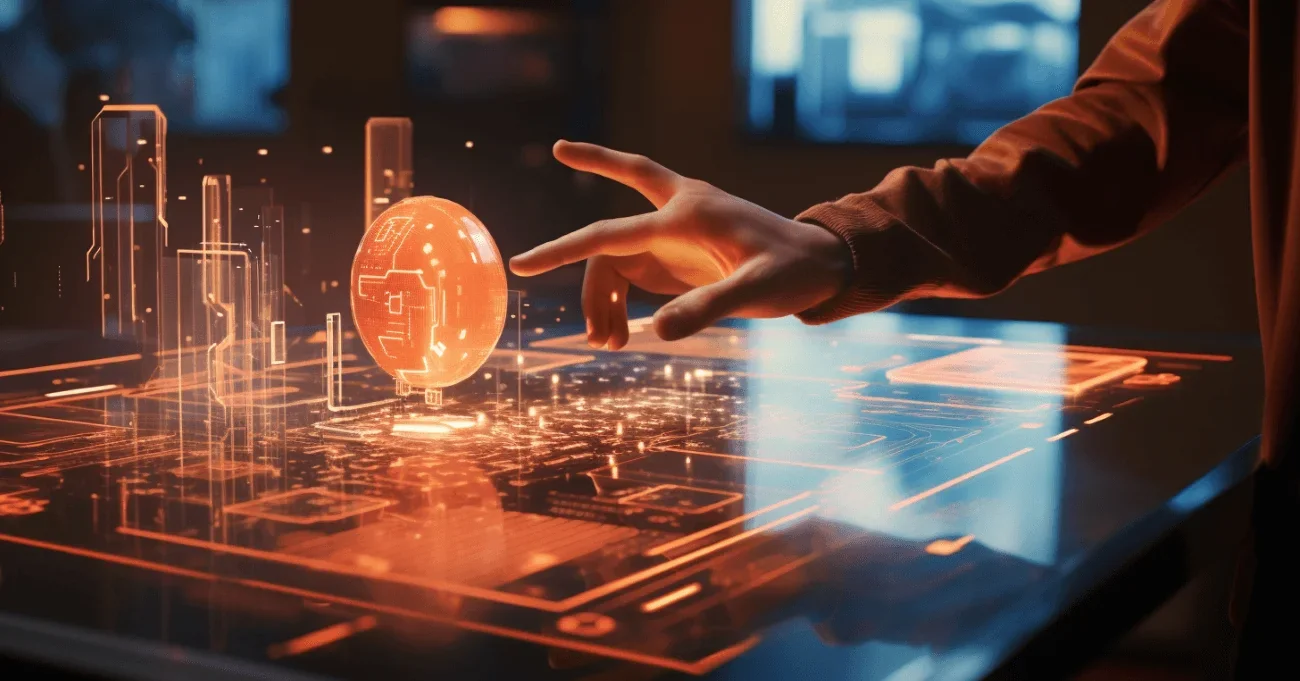In human-computer interaction, a fundamental inquiry often arises: "What are haptics?" This crucial question reflects the growing recognition of Haptics as a technology that enriches digital experiences by incorporating tactile sensations, allowing users to feel and interact with virtual environments more intuitively and engagingly.
At Aloa, we go beyond Haptics, providing deep insights into various emerging technologies. Whether you're curious about Haptics or eager to explore the broader landscape, Aloa simplifies the journey, making it accessible for enthusiasts and industry professionals to navigate the dynamic realm of tactile feedback and beyond.
In this blog post, we'll unravel the mysteries of Haptics, addressing the fundamental question, "What are haptics?" We'll explore the diverse applications of tactile feedback technology, its role in virtual reality, gaming, touchscreen technology, and beyond, providing you with a comprehensive understanding of its significance in the evolving tech landscape.
By the end of these insights, you'll be equipped with a well-rounded knowledge of Haptics and their impact on various domains.
Let's dive in!
What Are Haptics?
As technology evolves, the question 'What are haptics?' surfaces, prompting an exploration into this technology's diverse applications and significance. Haptics is simulating touch through vibrations or forces, enhancing user experiences in gaming, virtual reality, and touchscreen devices by creating an immersive, tactile connection between users and digital interfaces.
Amidst this technological evolution, Haptics emerged as a critical player, revolutionizing how we interact with the digital landscape. Beyond enhancing gaming and virtual reality, it extends its influence to touchscreen devices, adding a layer of physicality to everyday interactions. This innovative approach heightens engagement and fosters a more intuitive and responsive relationship between users and their devices.
By incorporating electrical signals, haptic touch technology communicates intricate vibration patterns to users' skin, simulating a range of physical sensations that resonate with nerve endings, enhancing the immersive nature of digital experiences.
Types of Haptics Technology
In haptic tech, various types cater to sensations, enriching user experiences across various devices.
Here are the common types of Haptics:
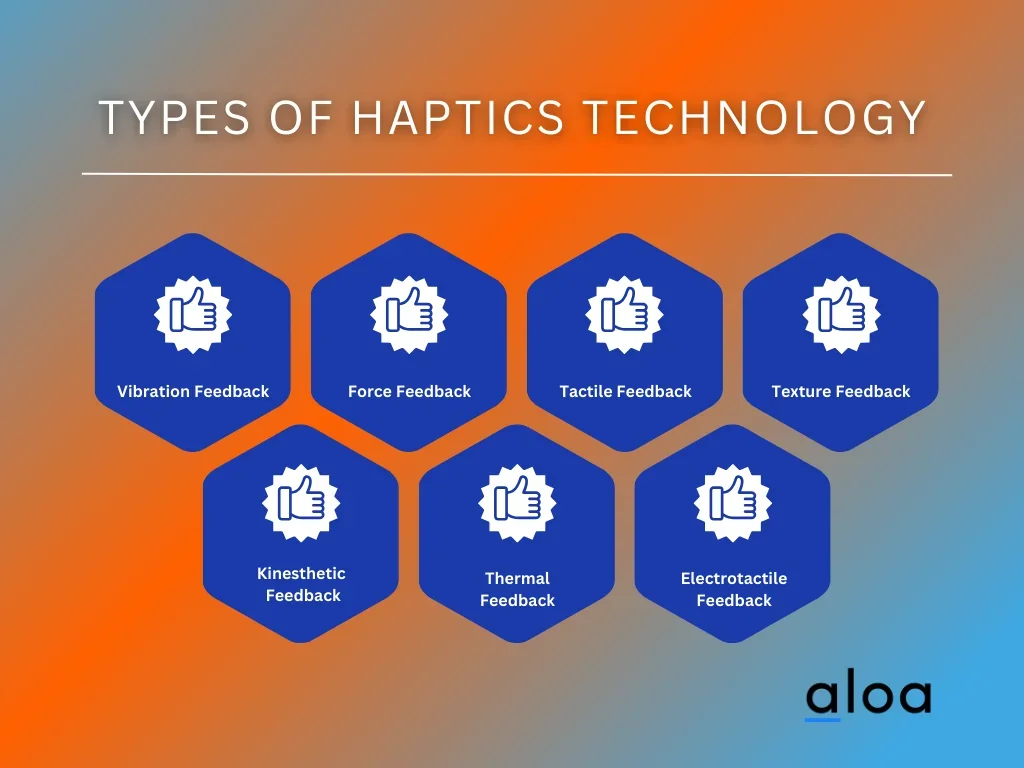
- Vibration: The most common form of haptic feedback, vibration is widely utilized in racing games to simulate the feel of road conditions or vehicle collisions, providing tactile stimuli that enhance the gaming experience. This technique often involves precise vibrations generated by mechanical devices embedded in gaming controllers, mobile phones, and other haptic devices.
- Force Feedback: Also known as haptic or active force feedback, this type replicates the impact of physical interactions in real life.
- Tactile Feedback: Utilizing mechanical devices to create a sense of touch, tactile feedback extends beyond gaming finding applications in mobile devices. It involves conveying information through physical sensations, enhancing the end user's connection to the digital world by incorporating the nuances of the human sense of touch.
- Texture Feedback: In virtual reality applications, texture feedback is crucial for creating a realistic environment. Simulating different surfaces and textures contributes to a more immersive experience, relying on vibrotactile feedback to convey the feel of various materials to the user.
- Kinesthetic Feedback: Integral to the sensation of movement and position, kinesthetic feedback plays a significant role in racing games, offering users a sense of acceleration, deceleration, and changes in direction, enhancing the overall sense of presence.
- Thermal Feedback: Although less common, thermal feedback in the form of temperature changes can be employed in haptic gloves to simulate sensations such as warmth or coolness. This adds an additional layer of immersion, appealing to the end user's sense of touch in a novel way.
- Electrotactile Feedback: Electrotactile feedback uses electromechanical motors and electrical pulses to create tactile sensations, adding a new dimension to haptic experiences in various applications, including gaming and simulations.
As technology evolves, understanding these common haptic types becomes increasingly crucial in navigating the landscape of touch feedback. The diverse applications of Haptics continue to shape how we interact with the digital world, promising a future where touch becomes a multi-dimensional and immersive experience for users of all kinds.
Use Cases of Haptics
Enthusiasts of emerging technologies often contemplate "What are haptics?" to stay informed about the latest developments. As we delve into the use cases of Haptics, we'll explore how haptic feedback technology is transforming diverse fields, from gaming and healthcare to education and beyond, enhancing user experiences in unprecedented ways.
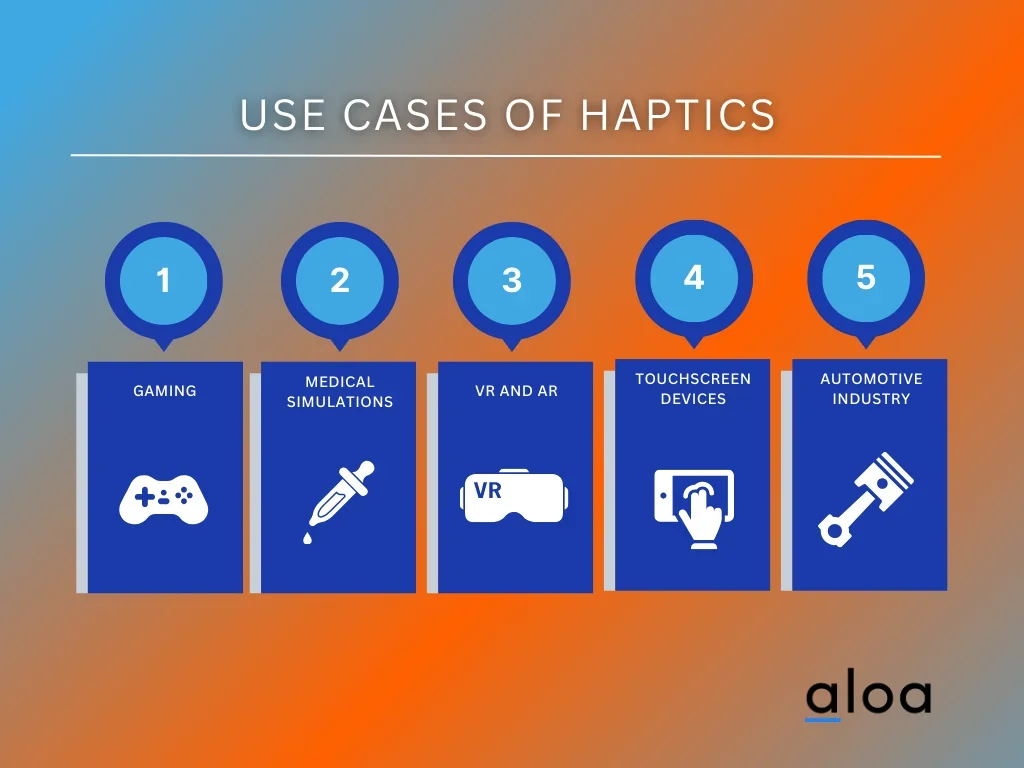
1. Gaming
Gamers and video game developers often ask, "What are haptics?" as they delve into the world of immersive gameplay in gaming. With its intricate sensory feedback, Haptics transforms gaming into a multisensory experience, allowing players to witness and physically sense the impact of their actions, creating a more immersive and engaging environment.
Here is how gaming is enhanced by the use of Haptics.
- Immersive Realism: Haptics elevates gaming by providing tactile feedback that lets players physically sense the impact of in-game actions, giving realistic sensations in the gaming experience.
- Enhanced Interaction: With haptic feedback, gaming becomes more interactive as players feel nuanced sensations, fostering a deeper connection and responsiveness to the virtual environment.
- Sensory-rich Adventures: Haptics enriches gaming adventures by allowing players to see, hear, touch, and feel the virtual world, creating a multisensory and captivating experience.
- Dynamic Environments: Haptics transforms gaming landscapes into dynamic realms, allowing players to experience changes in terrain, atmospheric conditions, and various in-game elements through realistic tactile feedback.
As Haptics continues redefining the gaming landscape, it emerges as a technological innovation and a transformative force shaping how players engage with digital realms.
2. Medical Simulations
In Medical Simulations, Haptics emerged as a groundbreaking tool, offering practitioners a realistic and immersive training environment. Its application in medical simulations becomes increasingly evident, transforming how healthcare professionals hone their skills.
Here is how Haptics revolutionizes medical training through simulations:
- Surgical Skill Refinement: Haptics enables surgical trainees to practice and refine their skills by providing realistic feedback, mimicking the tactile sensations encountered during surgery.
- Procedural Training: Medical professionals can engage in virtual procedural training, where haptic feedback replicates the sensations of various medical procedures, enhancing muscle memory and proficiency.
- Patient Interaction Simulation: Haptics facilitates simulations of patient interactions, allowing healthcare practitioners to practice examinations and procedures with a realistic touch element.
- Emergency Scenario Training: Haptic-enabled simulations create realistic emergency scenarios, helping medical professionals prepare for high-stress situations and make critical decisions under pressure.
The fusion of tactile feedback and healthcare training not only enhances skill development but also contributes to improved patient outcomes. Integrating Haptics in medical education promises a more competent and empathetic healthcare workforce, ultimately benefiting the quality of patient care.
3. Virtual Reality (VR) and Augmented Reality (AR)
When exploring virtual reality, one may ponder, "What are haptics?" to understand the role of touch sensations in the experience. In Virtual Reality (VR) and Augmented Reality (AR), Haptics become the linchpin for transporting users into a new dimension of immersive encounters.
Here is how Haptics amplifies these digital experiences:
- Tactile Presence: VR and AR introduce tactile, haptic feedback presence, allowing users, particularly in VR gaming, to physically interact with digital objects using innovations like VR gloves. This technology enables users to experience sensations as if they were part of the virtual or augmented space.
- Spatial Awareness: Through haptic feedback, users gain a heightened touch experience in virtual environments, feeling the distance, shapes, and textures of digital elements as if interacting with physical objects.
- Dynamic Interactions: Haptics adds a layer of dynamism to interactions in VR and AR, enabling users to feel the impact of their actions fostering a sense of agency and responsiveness in the digital realm.
- Immersive Storytelling: In VR and AR narratives, haptic feedback enriches storytelling by allowing users to feel the virtual world's emotional tones and physical nuances, creating a truly immersive narrative experience.
As Haptics continues to redefine the landscapes of Virtual Reality (VR) and Augmented Reality (AR), the boundaries between the physical and digital realms blur, offering users an unprecedented level of immersion and interaction.
4. Touchscreen Devices
When discussing advancements in touchscreen technology, the question naturally arises, "What are haptics?" to delve into the seamless integration of tactile feedback. In Touchscreen Devices, Haptics play a pivotal role, offering users a tangible and responsive interaction with their digital interfaces.
Here is how Haptics enhances the functionality of touchscreen devices:
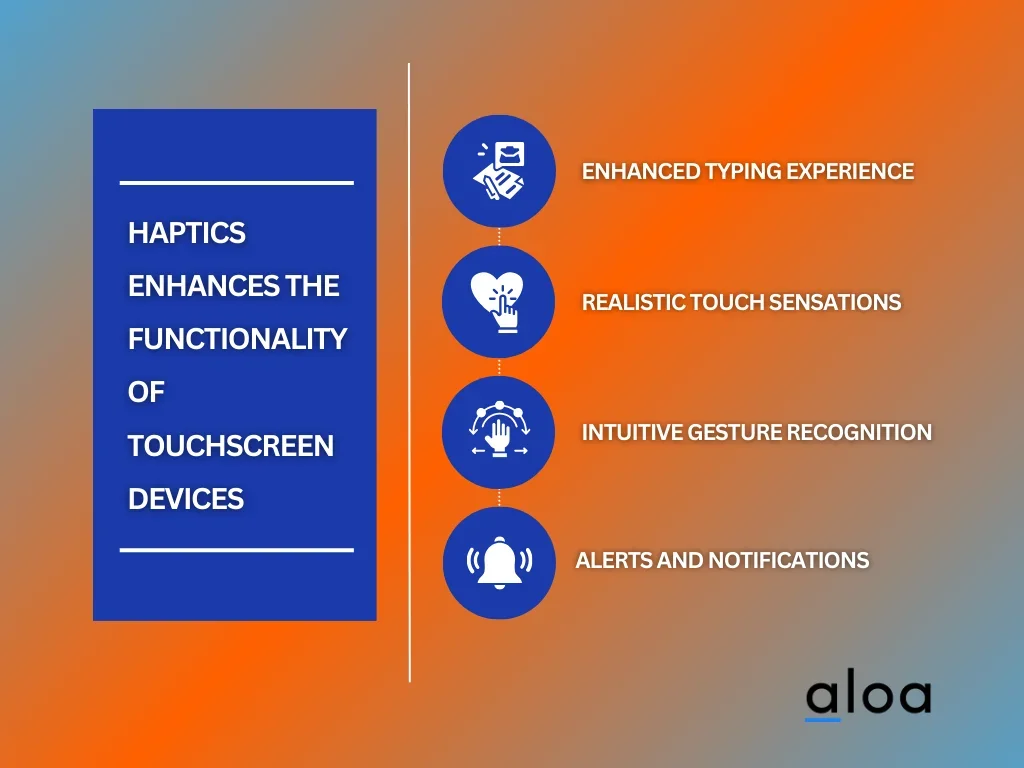
- Enhanced Typing Experience: Haptics refines the typing experience on touchscreens by providing tactile feedback for each keystroke, akin to the sensation of pressing a physical button, improving accuracy and responsiveness.
- Realistic Touch Sensations: Users can experience realistic touch sensations, such as the feeling of textures or the subtle vibrations of button presses, creating a more lifelike and engaging touchscreen experience.
- Intuitive Gesture Recognition: Haptic feedback aids intuitive gesture recognition, allowing users to feel the results of their gestures and promoting a more natural and responsive interaction with digital content.
- Alerts and Notifications: Haptics is an effective means for alerts and notifications, allowing users to feel vibrations or subtle motions and enhancing awareness without relying solely on visual cues.
The tactile feedback and digital interfaces refine user experiences and create more intuitive and immersive interactions.
5. Automotive Industry
In the automotive industry, Haptics' innovative technology reshapes the driving experience. With its tactile feedback capabilities, Haptics is not merely an addition but a transformative force, enhancing vehicle safety and interactivity.
Here's how Haptics is steering the automotive industry toward new horizons:
- Haptic Feedback in Navigation Systems: Drivers receive tactile cues through haptic feedback, providing a safer and more intuitive navigation experience.
- Collision Warnings with Tactile Alerts: Haptic technology delivers tactile warnings to alert drivers of potential collisions, enhancing responsiveness and safety on the road.
- Tactile Controls for Infotainment: Haptics is integrated into infotainment systems, allowing drivers to interact with touchscreens through tactile controls without diverting attention from the road.
- Immersive Driving Simulations: Haptic feedback creates realistic driving simulations, enabling engineers and designers to assess vehicle ergonomics and user experience.
Incorporating tactile feedback into the automotive industry advances safety measures. It transforms the driving experience into a more interactive and intuitive journey. The Haptics and automotive technology promise safer roads, enhanced user control, and a more enjoyable driving environment.
Importance of Haptics Technology
Enthusiasts of emerging technologies often contemplate "What are haptics?" to stay informed about the latest developments. Haptics technology, the science of touch feedback, has emerged as a transformative force across various industries, revolutionizing how we interact with digital environments.
Here are the importance of Haptics in fostering a more immersive, inclusive, and responsive technological landscape.
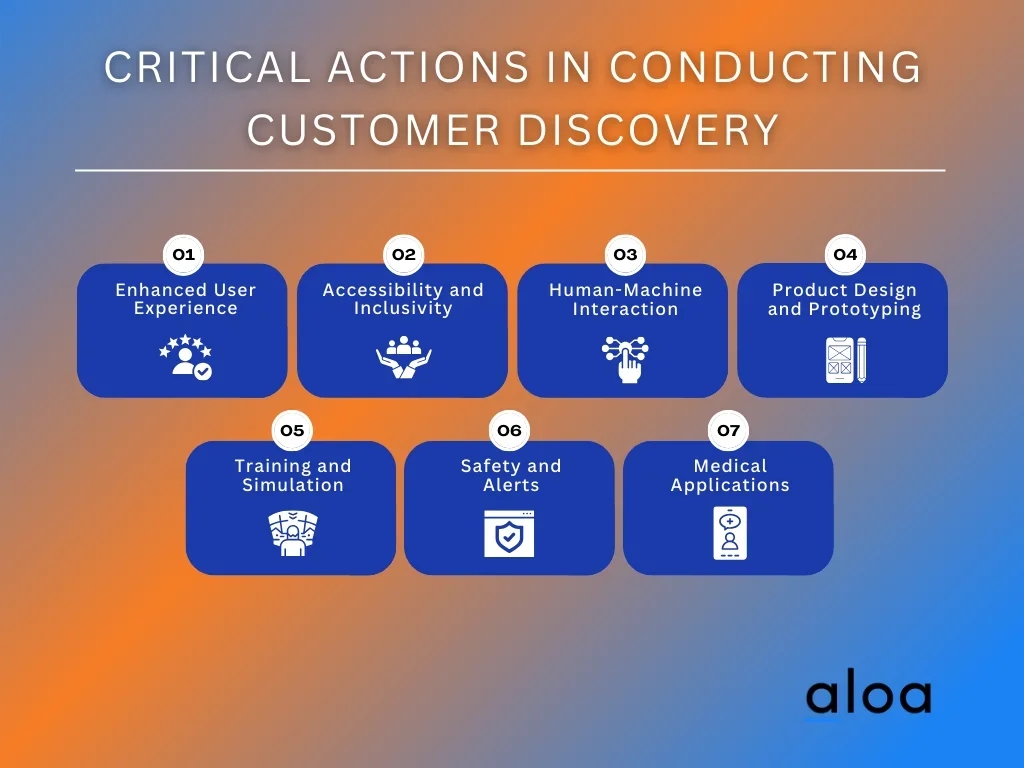
Enhanced User Experience
Haptics fundamentally transforms user experience by introducing a tactile layer to digital interactions. In immersive technologies like virtual reality (VR) and gaming, users are not merely observers; they become active participants, feeling the virtual environment through haptic feedback.
This multisensory engagement, involving touch, sight, and sound, creates a profound and unforgettable user experience. From the subtle vibration of a virtual object to the force feedback in a game controller, Haptics enriches the sensory palette, elevating digital interactions to a new level of realism and engagement.
Accessibility and Inclusivity
Haptic technology champions inclusivity in the digital realm, especially for individuals with visual or auditory impairments. Through tactile feedback, devices become accessible to a broader audience, ensuring that technology is a tool for empowerment rather than a barrier. The tactile cues Haptics provides enable those with impairments to navigate interfaces, receive alerts, and engage meaningfully with digital content.
This not only enhances accessibility but also fosters a more inclusive technological landscape where everyone, regardless of abilities, can participate and benefit from the digital revolution.
Human-Machine Interaction
Its transformative impact on human-machine interaction is at the core of haptic importance, particularly in touch-based interfaces like touchscreens. Haptics goes beyond mere responsiveness; it introduces touch sensations, making the interaction more intuitive and natural. Users feel tactile responses to their gestures, creating a seamless connection between the digital and physical worlds.
Whether it's the sensation of software keyboards clicking on a touchscreen or the subtle vibrations confirming an action, haptic feedback enhances the usability and satisfaction of interacting with devices, contributing to a more harmonious relationship between humans and their technology.
Product Design and Prototyping
Designers incorporating touch elements into their products frequently inquire, "What are haptics?" to enhance user experiences. In product design and prototyping, haptic technology is a game-changer, offering a tactile dimension that allows engineers to simulate the feel and ergonomics of a product. This invaluable tool enables real-time adjustments to optimize user experiences, ensuring the final product is visually appealing and ergonomically sound.
Haptics in product design marks a paradigm shift, where the sense of touch becomes a cornerstone in crafting innovative and user-centric designs, responding directly to designers' curiosity about integrating tactile elements.
Training and Simulation
Haptics is a linchpin in training and simulation, revolutionizing how professionals hone their skills in various fields. Integrating haptic feedback from medical procedures to aviation simulations provides a level of realism that was once unimaginable. Surgeons can feel the resistance and texture of virtual tissues during simulations, and pilots can experience the vibrations and forces of different flight conditions.
This tactile immersion in simulated scenarios improves skill acquisition. It reduces the gap between training and real-world application, ultimately enhancing the preparedness and competence of professionals in their respective domains.
Safety and Alerts
In safety and notifications, haptic feedback plays a silent yet critical role. When visual or auditory cues are insufficient or distracting, the sensation of touch becomes a reliable channel for delivering alerts. Whether it's a subtle vibration indicating a notification on a smartphone or a haptic warning in a vehicle navigation system, this tactile feedback ensures that users receive essential information without compromising their attention to the task at hand.
Haptic alerts, being non-intrusive yet attention-grabbing, contribute significantly to user safety in scenarios where maintaining focus is paramount.
Medical Applications
Haptics emerged as a groundbreaking force in the field of medicine, particularly in the realm of robotic surgery. The tactile feedback provided by haptic technology allows surgeons to 'feel' the virtual environment, experiencing the resistance and texture of tissues during minimally invasive procedures. Previously absent in traditional robotic surgeries, this sense of touch translates to enhanced precision, control, and skill.
Surgeons can navigate delicate procedures with a heightened level of awareness, leading to improved surgical outcomes, reduced complications, and an overall advancement in the capabilities of medical professionals leveraging robotic-assisted surgeries.
Key Takeaway
Exploring the intersection of neuroscience and technology prompts the question, "What are haptics?" as researchers investigate the sensory aspects of touch. As Haptics advances, its applications extend beyond entertainment, enhancing medical simulations, remote surgeries, and even facilitating communication for individuals with visual impairments.
Aloa provides insights into emerging technologies, delving into the forefront of innovation and exploration, with a keen interest in cutting-edge areas such as haptics technology. The organization's commitment to staying at the cutting edge allows it to offer invaluable perspectives on the latest advancements, influencing industries and shaping the landscape of technology.
To learn more about how Aloa can guide your exploration of innovative solutions, connect with us through [email protected]. Our experts are ready to engage and share knowledge to drive your understanding of the ever-evolving technological landscape.

